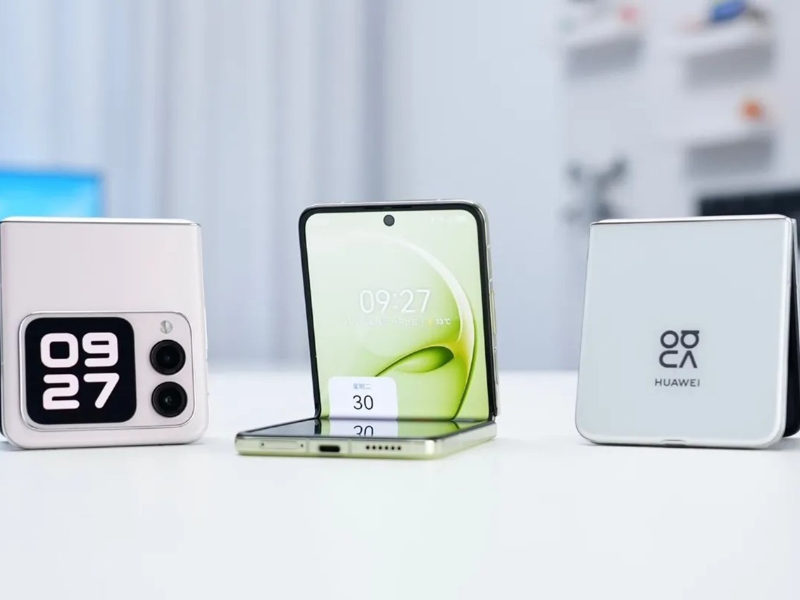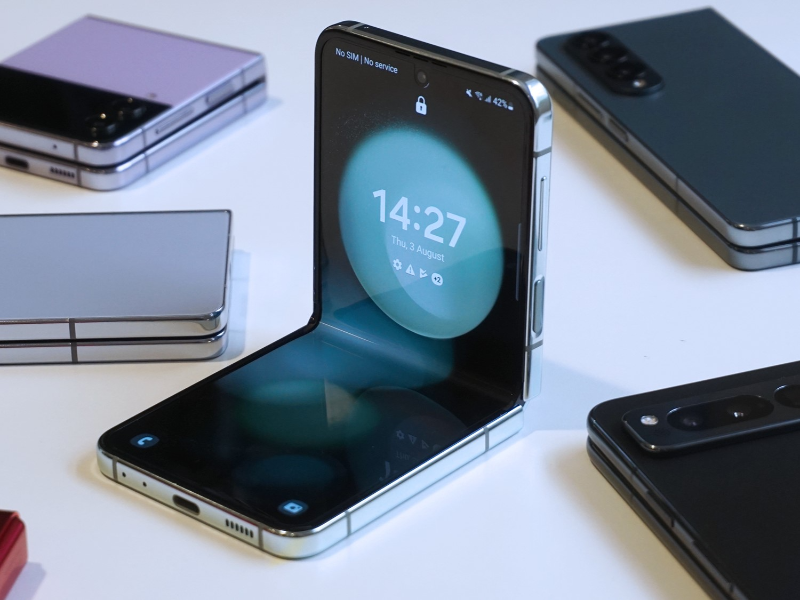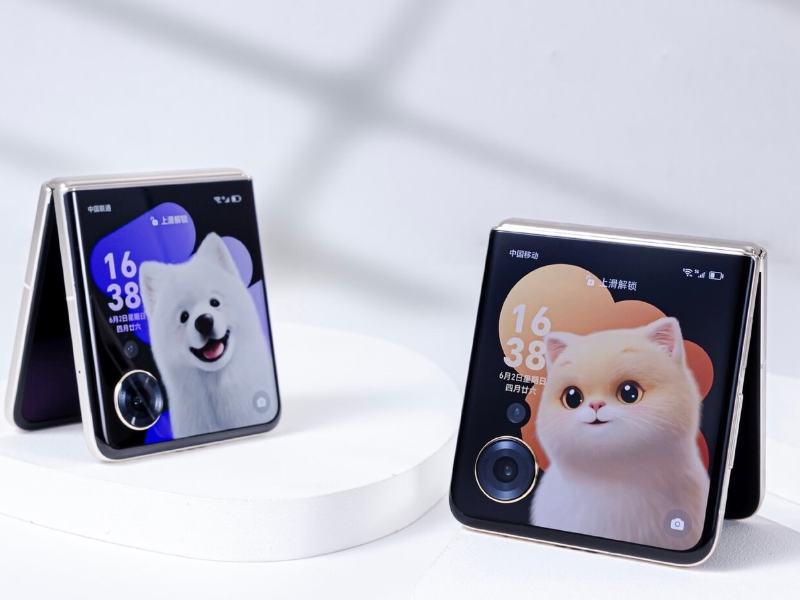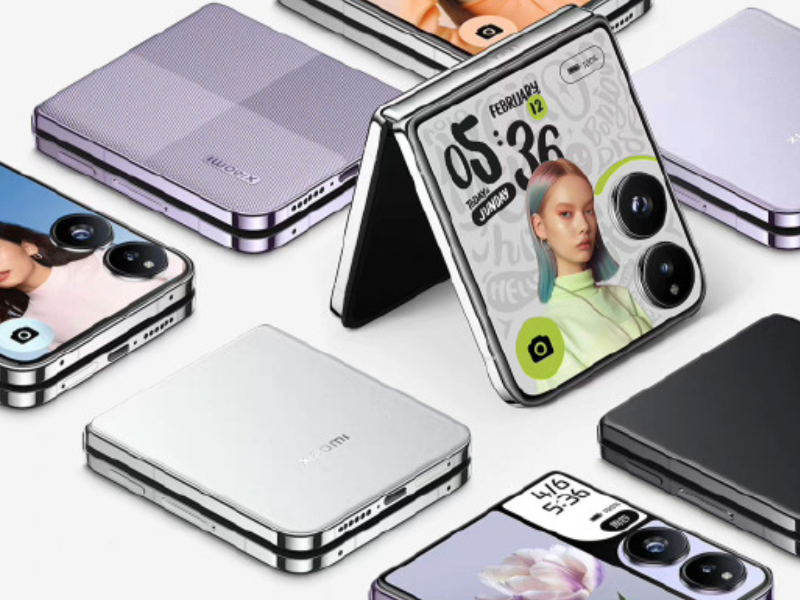- This summer, smartphone manufacturers including Huawei, Samsung, Xiaomi, and Honor are fiercely competing in the clamshell foldable phone market with innovative launches, each pushing the boundaries of design and technology to redefine the future of mobile devices.
- The appeal of clamshell foldable phones to female users is driving manufacturers to tailor designs, functionalities, and accessories specifically for this demographic, while the foldable phone market continues to expand rapidly, offering a bright spot amidst declining smartphone sales.
OUR TAKE
As I see it, clamshell foldables are a strategic move by manufacturers to tap into a niche yet rapidly expanding market, particularly appealing to female users. Despite facing challenges, these devices represent innovation and offer manufacturers a chance to differentiate themselves in a crowded marketplace.
–Vicky Wu, BTW reporter
If you take a stroll around the showrooms of major smartphone retailers these days, you’ll notice something interesting. Whether you’re in a Xiaomi, Honor, or Huawei store, the prime spots are now dominated by vibrant, compact, flip-style foldable phones that are almost the size of a powder compact. Flagship flat-screen models have been relegated to the sidelines. These clamshell foldable phones, often referred to as “mini-folds,” are easy to grip and fit comfortably in the palm, making them a dream come true for fans of clamsheller devices.
While the competition for the mini-fold market appears lively, the reality is a bit more subdued. Despite their charming looks, these gadgets are expensive, prone to breaking, and often don’t offer the same specs as their flat-screen counterparts at the same price point. So why are manufacturers still fighting tooth and nail over this market? Are these pretty little things really just “chicken ribs” – nice to have, but not essential?

Summer showdown: Intense competition in the clamshell foldable phone market
This summer, the clamshell foldable phone market is sizzling with intense competition, as smartphone manufacturers vie to outshine one another with their latest innovations. Each brand is pushing the boundaries of design and technology, aiming to redefine the future of mobile devices.
Huawei, a stalwart player in the clamshell foldable segment, launched the nova series Flip on August 5. Targeted at a younger, trend-conscious demographic, this device is priced around $700. The Huawei nova Flip boasts a sleek and compact design, with a vibrant OLED display that offers vivid colours like Fresh Green, Cherry Pink, and Starlight Black. Under the hood, a HiSilicon Kirin 8000 chipset ensures powerful performance, making it a compelling choice for tech-savvy young adults.
Samsung, often hailed as the trailblazer in clamshell foldables, refreshed its lineup with the Galaxy Z Flip6 in China. Since the launch of the original Galaxy Z Flip in 2020, which sold 500,000 units, Samsung has released the sixth generation of its clamshell foldables, solidifying its position in this market. The Galaxy Z Flip6 builds on the success of its predecessors with a refined design, featuring an advanced third-generation Snapdragon 8 Mobile Platform for Galaxy. This chipset, coupled with an improved 120Hz LTPO OLED display, offers a smoother user experience and top-notch performance.

Xiaomi joined the fray during Lei Jun’s annual speech, unveiling its first MIX Flip after years of development and numerous discarded prototypes. The MIX Flip represents Xiaomi’s entry into the foldable arena, with a focus on cutting-edge technology and design. Boasting a Qualcomm Snapdragon 8 Gen 2 chipset for robust performance and a durable hinge mechanism designed to withstand thousands of folds, the MIX Flip is poised to establish Xiaomi as a serious contender in this rapidly evolving market.
Honor, which has been aggressively pursuing the foldable market, launched its Magic V Flip in June. Priced more competitively than models from OPPO and Vivo by $140, and $420 to $560 below Huawei and Samsung’s offerings, Honor is leveraging aggressive pricing to boost sales and market share. The Magic V Flip combines advanced features and affordability, featuring a high-refresh-rate OLED display for a smooth visual experience and a powerful chipset for seamless multitasking, all wrapped in a sleek and lightweight package. This device positions itself as a competitive option for consumers seeking high-performance clamshell foldable smartphones, without breaking the bank.
Pop quiz:
Which of the following statements about the clamshell foldable phone market is true?
A. Huawei’s nova series Flip is targeted at a younger, trend-conscious demographic and is priced around $700.
B. Samsung’s Galaxy Z Flip6 is the third generation of its clamshell foldables and uses a Snapdragon 8 Mobile Platform for Galaxy.
C. Xiaomi’s MIX Flip was unveiled after years of development and features a Qualcomm Snapdragon 8 Gen 1 chipset.
D. Honor’s Magic V Flip is priced higher than models from OPPO and Vivo but lower than Huawei and Samsung’s offerings.
The correct answer is at the bottom of the article.
The struggle of clamshell foldables: Balancing size, cost, and performance in a growing market
Despite the flurry of activity, the clamshell foldable segment faces a difficult challenge, especially given the overall growth in the foldable market. According to IDC data, in 2023, China’s foldable phone market saw shipments of 7 million units, up 114.5% year-on-year. However, the share of clamshell foldables fell by over 10%, accounting for just 30% of the total, or less than 2.5 million units.
This downward trend continued into 2024. In the first quarter, while overall foldable phone sales grew by 48%, the increase was driven by larger, horizontally folding models, whose sales surged 91%. In contrast, clamshell foldables experienced a 1% decline.
The primary advantage of clamshell foldables is their compact and lightweight nature. However, achieving a balance between size, price, and performance presents a significant challenge. A report from Guosen Securities in 2022 compared the costs of Samsung’s Galaxy Fold and non-foldable Galaxy S9+, finding that the folding model cost 69% more to produce.
Foldable glass and hinges are the most expensive components in foldable phones. For instance, the foldable glass in the Galaxy Z Flip costs approximately $40, 20 times higher than a standard screen. Reports suggest that the hinge for the OPPO Find N3 Flip costs over $100. These additional costs amount to nearly $145, excluding R&D and software adaptation expenses.
High-end foldables can justify their premium prices by targeting business users, but clamshell foldables face competition from budget-conscious customers who prefer traditional smartphones. Struggling to raise prices while maintaining profitability, manufacturers cut corners on components like chips and cameras. For example, the Honor Magic V Flip uses the older Snapdragon 8+ Gen 1, while the cheaper Honor Magic 6 is equipped with the newer Snapdragon 8 Gen 3.

In terms of performance, clamshell foldables lag behind. They suffer from several drawbacks in practical use, such as rapid battery drain, screens that wear out quickly, visible creases over time, and reduced longevity due to performance compromises. These issues discourage potential buyers, earning clamshell foldables the unflattering nickname “beautiful little waste.”
Unable to command premium prices and struggling to sell in volume, consumers find clamshell foldables to be superfluous, leaving manufacturers expending effort for little return. Analysts had previously noted that Oppo and Vivo, who launched their clamshell foldables two years before Xiaomi and Honor, were considering discontinuing them in 2024 due to slim profit margins. Between 2020 and 2023, Huawei, Samsung, Oppo, Vivo, Xiaomi, and Honor released 23 large foldable phones in China, compared to just 10 clamshell foldables, of which Samsung accounted for five.
It’s clear that phone makers are hesitant about advancing with clamsheller foldables. Yet, no major phone manufacturer has opted out of the foldable clamshell-screen market. In response to rumours of an exit, Oppo confirmed that its folding series products remain on track, while Vivo launched a large foldable as a token of commitment. Even with Xiaomi and Honor entering the fray, this low-volume, high-effort market has become increasingly competitive. What keeps drawing phone manufacturers to this segment?
Also read: Apple plans to launch its first foldable iPhone in 2026
Also read: HP Rolls Out a High Performance Foldable PC: The Spectre
The appeal of clamshell foldables to female users: A market segment eagerly pursued by manufacturers
For Xiaomi, the discovery that the MIX Flip resonated with the female market turned it into a must-make device.
Since its humble beginnings, Xiaomi has crafted its identity around affordability and bleeding-edge specs, appealing to tech-savvy males but unintentionally sidelining female fans. Xiaomi once held the dubious distinction of having the lowest female user ratio among smartphone brands, with less than one-third of its customers being women. Samsung and Huawei weren’t faring much better, each capturing less than 40% of female users, while Oppo and Vivo had a somewhat stronger foothold among women. Meanwhile, the iPhone, with its hefty price tag typically exceeding £5,000, enjoys the loyalty of the largest female user base, making up more than half of its customers—a significant demographic with considerable purchasing power.
The recent triumph of Xiaomi’s SU7 car has revealed the potential to attract female customers, with over 40% of buyers being women, and 51.9% of them also being Apple device owners. The MIX Flip is aimed squarely at these female SU7 owners and other women, representing the growth Xiaomi is eager to capture.
This symmetrically dual-outer-folding form factor perfectly merges the experience of a tablet and a phone; it’s both practical and beautiful.
Lin Bin, vice chairman and co-founder of Xiaomi
Clamshell foldable phones, it seems, have a particular allure for female users. According to a JD.com report, in 2022, the number of female buyers of clamshell foldable phones tripled. An iResearch report also highlights that female users constitute nearly 3 percentage points more of the clamshell foldable phone market compared to male users.
Manufacturers have gone to great lengths to tailor their offerings to female users through design, functionality, and accessories. In terms of aesthetics, clamshell foldables are often adorned with hues that are perceived as more feminine, such as the pink of the Oppo Find N3 Flip or the purple of the vivo X Flip. Functionally, the main selling point is often the “rear camera selfie” feature, offering superior image quality and innovative outer screen photography options. Accessories like pearl chains or fashion-forward phone case designs add to the overall appeal. Software features, such as scrolling through social media apps like Xiaohongshu on the outer screen of the Oppo Find N2 Flip, or the Huawei Pocket 2’s ability to accurately reproduce makeup during photos and monitor UV protection, strike a chord with female users. Many clamshell foldable phones also emphasise the “makeup mirror” feature, directly demonstrating manufacturers’ efforts to court female users. While these hardware settings may inadvertently reinforce gender stereotypes, they’re undeniably effective.
According to iResearch, in 2023, 55.7% of those paying attention to foldable phones were female, compared to 44.3% male interest.

While sales figures may not always match the hype, Samsung’s growth in the clamshell foldable segment is truly impressive. In 2023, clamshell foldable phones accounted for 31.9% of sales in China, with 2.235 million units sold. DSCC data indicates that global shipments of foldable phones reached 7 million units in Q3 2023, marking a 16% increase year-on-year. The Samsung Galaxy Z Flip5 dominated the global market with 45% share, becoming the best-selling foldable phone of the quarter.
The Flip series has been key to Samsung’s reign in the foldable market. Ever since the first Galaxy Z Flip unexpectedly became a hit, the series has consistently delivered robust sales numbers. In 2022, the Galaxy Z Flip4 captured 52% of the market, securing its position as the best-selling foldable phone globally.
Clamshell foldables certainly have a market, but the opportunities are finite. In Q1 of this year, Huawei emerged as the leader in the foldable market with a 35% share, thanks to two highly successful models—one of which was the new clamshell foldable Pocket 2, powered by a Kirin chipset, and marketed with the catchy slogan “beautiful and not wasteful” to target the female demographic.
The foldable smartphone will forever change the consumer electronics industry, as well as the way people interact with and perceive their world.
Bill Liu, CEO of Royole
The rapid rise of foldables: A bright spot amidst declining smartphone sales
In the vast landscape of the global smartphone market, foldable devices currently occupy a tiny corner, holding less than 1.5% of the share. But there’s a silver lining: according to forecasts by Canalys, the foldable phone market is poised to grow at an impressive compound annual growth rate of 26.8% from 2024 to 2028, reaching a total of 53 million units. That’s a significant leap, bringing the foldable segment to 4% of the global market – a testament to the potential of this niche but rapidly expanding category.
With consumers hanging onto their devices for longer periods, the global smartphone market has been in a steady decline. In 2023, global smartphone shipments slumped by 3.2% to 1.17 billion units, marking the lowest annual figure in ten years. The Chinese market, too, felt the pinch of economic downturn, with annual shipments dropping by 5%.
Traditional smartphones, despite their multiple cameras and partnerships with esteemed camera companies like Leica and Zeiss, have lost their novelty. Incremental feature improvements are no longer enough to entice consumers to upgrade.
Enter the foldable phone market, which burst onto the scene with its first commercial release in 2019 and has since seen consecutive yearly growth rates above 100% in China. The second quarter of 2024 witnessed a surge in the foldable phone market, growing by 104.6% year-on-year. Foldables stand shoulder-to-shoulder with flagship conventional smartphones, offering a fresh take on the familiar form factor and enabling manufacturers to break through the price ceiling and secure rich profits.
Take the vivo X Fold3, for example, boasting a sleek 219-gram weight, a stark contrast to the hefty 300-gram Huawei MateXs from four years ago. On the pricing front, the Honor Magic Vs2 starts at $980, comparable to a flagship conventional smartphone. Contrast this with the initial price of the Huawei MateXs at $2,400, which, due to shortages, was resold for an eye-watering $4,200 to $5,600. Between 2021 and 2023, the average selling price of large foldables dropped by around 30%. This year, manufacturers have been embroiled in a price war to carve out a piece of the foldable pie.
As a result, we will continue to see more innovation on the Internet and on mobile phones than on consoles.
Trip Hawkins, founder of Electronic Arts
As supply chains mature and research and development costs decrease, subsequent iterations of foldables have become more affordable, lighter, and more versatile, making them increasingly attractive to consumers. Clamshell foldables are likely to follow a similar path.
Even if the product line for clamshell foldables doesn’t prove sustainable, innovation in smartphones and competition in screen form factors will continue unabated.
According to The Information, Apple’s long-awaited foldable iPhone could make its debut as early as 2026, marking a significant departure from mere colour changes. Patent images hint at a device with multiple hinges, enabling multi-directional folding.
Tri-fold devices are also on the horizon. Huawei’s Executive Director, Richard Yu, was recently seen using a tri-fold device, and supply chain sources confirm that Huawei plans to release a tri-fold device in the third and fourth quarters of this year.
The tri-fold market is set to become the next battlefield in the smartphone industry. After all, for today’s smartphone manufacturers, every narrow path represents a way forward, and every clamshell growth market is worth fighting for.
The correct answer to the pop quiz is A. Huawei’s nova series Flip is targeted at a younger, trend-conscious demographic and is priced around $700.
